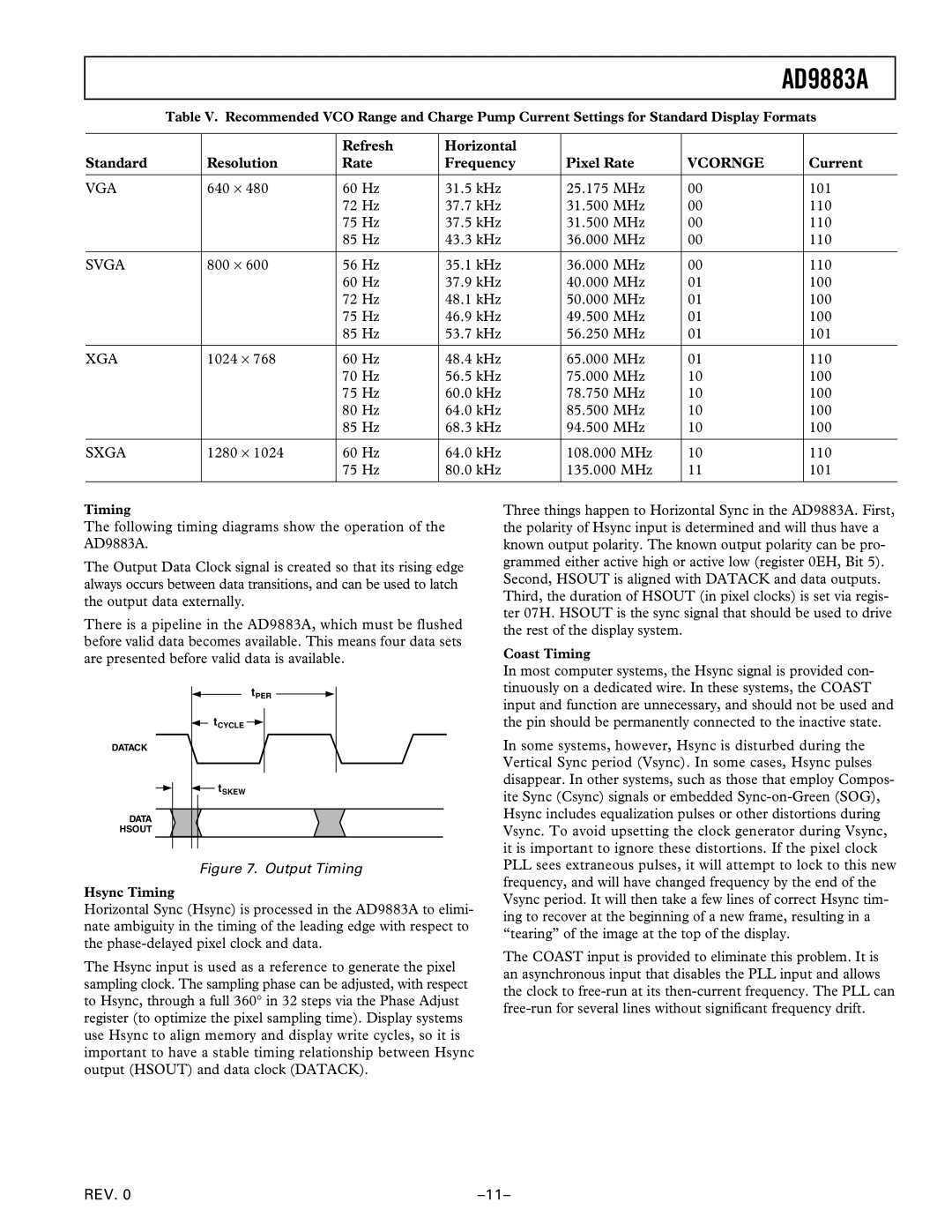
|
|
|
|
|
|
| AD9883A | |
|
|
|
|
|
|
|
| |
| Table V. Recommended VCO Range and Charge Pump Current Settings for Standard Display Formats | |||||||
|
|
|
|
|
|
|
|
|
|
|
| Refresh | Horizontal |
|
|
|
|
Standard |
| Resolution | Rate | Frequency | Pixel Rate | VCORNGE |
| Current |
|
|
|
|
|
|
|
|
|
VGA |
| 640 ⋅ 480 | 60 Hz | 31.5 kHz | 25.175 MHz | 00 |
| 101 |
|
|
| 72 Hz | 37.7 kHz | 31.500 MHz | 00 |
| 110 |
|
|
| 75 Hz | 37.5 kHz | 31.500 MHz | 00 |
| 110 |
|
|
| 85 Hz | 43.3 kHz | 36.000 MHz | 00 |
| 110 |
|
|
|
|
|
|
|
|
|
SVGA |
| 800 ⋅ 600 | 56 Hz | 35.1 kHz | 36.000 MHz | 00 |
| 110 |
|
|
| 60 Hz | 37.9 kHz | 40.000 MHz | 01 |
| 100 |
|
|
| 72 Hz | 48.1 kHz | 50.000 MHz | 01 |
| 100 |
|
|
| 75 Hz | 46.9 kHz | 49.500 MHz | 01 |
| 100 |
|
|
| 85 Hz | 53.7 kHz | 56.250 MHz | 01 |
| 101 |
|
|
|
|
|
|
|
|
|
XGA |
| 1024 ⋅ 768 | 60 Hz | 48.4 kHz | 65.000 MHz | 01 |
| 110 |
|
|
| 70 Hz | 56.5 kHz | 75.000 MHz | 10 |
| 100 |
|
|
| 75 Hz | 60.0 kHz | 78.750 MHz | 10 |
| 100 |
|
|
| 80 Hz | 64.0 kHz | 85.500 MHz | 10 |
| 100 |
|
|
| 85 Hz | 68.3 kHz | 94.500 MHz | 10 |
| 100 |
|
|
|
|
|
|
|
|
|
SXGA |
| 1280 ⋅ 1024 | 60 Hz | 64.0 kHz | 108.000 MHz | 10 |
| 110 |
|
|
| 75 Hz | 80.0 kHz | 135.000 MHz | 11 |
| 101 |
|
|
|
|
|
|
|
|
|
Timing
The following timing diagrams show the operation of the AD9883A.
The Output Data Clock signal is created so that its rising edge always occurs between data transitions, and can be used to latch the output data externally.
There is a pipeline in the AD9883A, which must be flushed before valid data becomes available. This means four data sets are presented before valid data is available.
tPER |
tCYCLE |
DATACK |
tSKEW |
DATA |
HSOUT |
Figure 7. Output Timing
Hsync Timing
Horizontal Sync (Hsync) is processed in the AD9883A to elimi- nate ambiguity in the timing of the leading edge with respect to the
The Hsync input is used as a reference to generate the pixel sampling clock. The sampling phase can be adjusted, with respect to Hsync, through a full 360° in 32 steps via the Phase Adjust register (to optimize the pixel sampling time). Display systems use Hsync to align memory and display write cycles, so it is important to have a stable timing relationship between Hsync output (HSOUT) and data clock (DATACK).
Three things happen to Horizontal Sync in the AD9883A. First, the polarity of Hsync input is determined and will thus have a known output polarity. The known output polarity can be pro- grammed either active high or active low (register 0EH, Bit 5). Second, HSOUT is aligned with DATACK and data outputs. Third, the duration of HSOUT (in pixel clocks) is set via regis- ter 07H. HSOUT is the sync signal that should be used to drive the rest of the display system.
Coast Timing
In most computer systems, the Hsync signal is provided con- tinuously on a dedicated wire. In these systems, the COAST input and function are unnecessary, and should not be used and the pin should be permanently connected to the inactive state.
In some systems, however, Hsync is disturbed during the Vertical Sync period (Vsync). In some cases, Hsync pulses disappear. In other systems, such as those that employ Compos- ite Sync (Csync) signals or embedded
The COAST input is provided to eliminate this problem. It is an asynchronous input that disables the PLL input and allows the clock to
REV. 0 |
